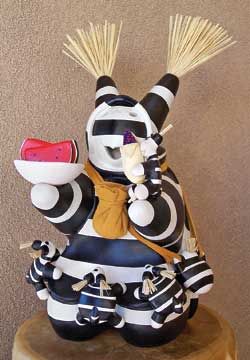By Dottie Indyke

A Choctaw sculptor whose journey has taken him from Mississippi to New Mexico
Randy Chitto’s motif is the turtle, an image he happened upon a quarter-century ago in a ceramics class at the Institute of American Indian Arts. Shaping an oblong vessel, it struck him that the form was similar to a turtle’s upright body. “I gave it legs, a head, and arms,” he recalls. “The teacher said, ‘Slow down, it’s too wet and heavy,’ but I was so excited. By 4:15 it was looking like a real turtle, and by 5:00 it was almost done.”
Chitto, who is of Choctaw heritage, put the sculpture in a wet box to keep it moist over the weekend. But on Monday, all that was left was a melted lump of clay. The failure did nothing to squelch his enthusiasm. On the contrary, he had found his calling.
According to Choctaw legend, when the Trail of Tears forced the tribe to relocate, its medicine people instructed the elders to share their stories with three sacred animals—the bear, the raccoon, and the turtle. That way, if the people never returned, these animals would keep their spirits alive. Ever since, the turtle has been both story keeper and story teller for the tribe.
Chitto’s ceramic turtle storytellers make up a clan of their own—turtles in bear suits, turtles crawling with baby turtles, turtles with bowl bodies. Many have assumed the identity of the Hopi koshare, or striped clown, and appear in varied depictions such as golfers, tennis aficionados, and watermelon-eaters.
Since their inception, demand for Chitto’s turtles has outstripped supply. His student pieces back in the 1980s were still warm from the firing when he delivered them to the IAIA gift shop; two days later they were sold out. Fifteen pieces he made for his senior show were gone in a matter of hours.
The turtles’ popularity is, in part, a reflection of Chitto’s own cheery charisma. Each has a flirtatious smile and totes a miniature medicine pouch that dangles from its rotund body. Inspired by the Choctaw story of warriors who placed dirt in their pouches so their spirits could find the way home if they died in battle, Chitto stuffs each pouch with a tiny ceramic shard from an early sculpture that broke in the firing.
Born on the Choctaw reservation in Philadelphia, MS, to two Choctaw parents, Chitto moved with his family to Chicago, IL, when just a toddler. An avid athlete, he thought until adolescence that he’d be a baseball player, but the undercurrent of art, and advertising art in particular, pulled him in another direction. A friend’s father was a designer for Wrigley’s chewing gum, and Chitto loved to hover around his drawing table, which was stocked with multicolored pens. Perhaps the final clincher was observing the interaction between his mother, an amateur beader, and her clients. “They had so much respect for her work,” Chitto remembers. “I loved the oohs and aahs they gave her.”
He decided to pursue a degree in commercial art but was offered only partial scholarships at the Art Institute of Chicago and the American Academy of Art. His tribe was willing to offer some money, but Chitto had missed their deadline. They suggested he wait a semester and instead attend an emerging art school in Santa Fe, NM—the Institute of American Indian Arts.
Santa Fe, circa 1980, came as a shock to the citified Chitto. The desolate high-desert landscape, lack of public transportation, and what he first took to be an unsophisticated art education boggled his mind. But slowly Santa Fe worked its charms. Chitto met his future wife, Jackie; he played on the school’s basketball team; and he found his medium.
“I had never touched clay before,” he says. “I was one of those urban painting elitists who thought sculpture might be fine art—if it was marble. But once I started making pots, painting wasn’t art anymore.”
After college, he got a job firing tiles. It lasted all of a week. Sales of his sculptures at the Case Trading Post at Santa Fe’s Wheelwright Museum were so brisk, it didn’t make sense for him to work for anyone but himself, he decided. That was the last job he ever held.
Ask Chitto, now 44, the father of two teenage sons, and an active member of the Santa Fe community, and he’ll tell you he can hardly believe his luck: He does what he loves and earns a living at it. Sitting among his convivial turtles, he offers a cockeyed grin. “All artists do autobiographical pieces,” he muses. “My wife explains that my pieces have my smile. And they tend to gain and lose weight as I do.”
Chitto is represented by Packard’s on the Plaza, Santa Fe, NM; Case Trading Post, Santa Fe, NM; Smith-Klein Gallery, Boulder, CO; and www.rchitto.com.
Featured in “Native Arts” April 2006





